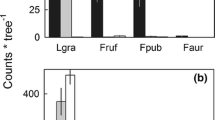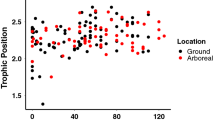Abstract
Ants are thought to exert an important influence on the structure of arthropod assemblages through predation and competition. I examined the effect of a dominant ant, Iridomyrmex purpureus, on epigaeic arthropod assemblages on rock outcrops using an exclusion experiment. I compared arthropod assemblages on four replicate outcrops allocated to each of the following treatments: I. purpureus present; I. purpureus absent; I. purpureus excluded; and procedural control. Nests of I. purpureus were caged in summer 2001 and epigaeic arthropod assemblages were sampled at all sites using pitfall traps in autumn and spring 2001 and summer 2002. I also collected items from foraging workers to determine the diet of I. purpureus. Exclusion cages successfully reduced the abundance of I. purpureus workers in pitfall traps by more than 97%. Exclusion of I. purpureus did not affect the size distribution, biomass or abundance of arthropod predators or non-predatory arthropods, although the total biomass of ants was greater at sites with I. purpureus. Spider biomass, species richness, abundance and composition were also not affected by the presence of I. purpureus, although the I. purpureus mimic and specialist predator, Habronestes bradleyi, became less abundant at sites from which I. purpureus was excluded. Predation by I. purpureus on other arthropods may not have a significant effect on epigaeic arthropod communities, but the complex role of I. purpureus in this ecosystem and the high diversity of species belonging to multiple trophic levels may obscure its effects in this system.


Similar content being viewed by others
References
Allan RA, Elgar MA, Capon RJ (1996) Exploitation of an ant chemical alarm signal by the zodariid spider Habronestes bradleyi Walckenaer. Proc R Soc Lond B 263:69–73
Bishop DB, Bristow CM (2001) Effect of Allegheny Mound Ant (Hymenoptera: Formicidae) presence on homopteran and predator populations in Michigan Jack Pine forests. Ann Entomol Soc Am 94:33–40
Brüning A (1991) The effect of a single colony of the red wood ant, Formica polyctena, on the spider fauna (Araneae) of a beech forest floor. Oecologia 86:478–483
Brusca RC, Brusca GJ (1990) Invertebrates. Sinauer, Sunderland, Mass., USA
Cherix D, Bourne JD (1980) A field study on a super-colony of the red wood ant Formica lugubris Zett. in relation to other predatory arthropods (spiders, harvestmen and ants). Rev Suisse Zool 87:955–973
Clarke KR, Gorley KR (2001) Primer 5. Primer-E, Plymouth, UK
Clarke KR, Warwick RM (1994) Change in marine communities: an approach to statistical analysis and interpretation. Plymouth Marine Laboratory, UK
Colwell RK, Fuentes ER (1975) Experimental studies of the niche. Annu Rev Ecol Syst 6:281–310
Ettershank G, Ettershank JA (1982) Ritualized fighting in the meat ant Iridomyrmex purpureus (Hymenoptera: Formicidae). J Aust Entomol Soc 21:97–102
Fernandes GW, Fagundes M, Woodman RL, Price PW (1999) Ant effects on three-trophic level interactions: plant, galls, and parasitoids. Ecol Entomol 24:411–415
Fowler SV, MacGarvin M (1985) The impact of hairy wood ants, Formica lugubris, on the guild structure of herbivorous insects on birch, Betula pubescens. J Anim Ecol 54:847–855
Frazer BD, Van den Bosch R (1973) Biological control of the walnut aphid in California: the interrelationship of the aphid and its parasite. Environ Entomol 2:561–568
Greenslade PJM (1973) Sampling ants with pitfall traps: digging-in effects. Insectes Soc 20:343–353
Greenslade PJM (1976) The meat ant Iridomyrmex purpureus (Hymenoptera: Formicidae) as a dominant member of ant communities. J Aust Entomol Soc 15:237–240
Halaj J, Ross DW, Moldenke AR (1997) Negative effects of ant foraging on spiders in Douglas-fir canopies. Oecologia 109:313–322
Hoffmann BD, Andersen AN, Hill GJE (1999) Impact of an introduced ant on native rain forest invertebrates: Pheidole megacephala in monsoonal Australia. Oecologia 120:595–604
Hölldobler B, Wilson EO (1990) The Ants. Springer, Berlin Heidelberg New York
Howard FW, Oliver AD (1978) Arthropod populations in permanent pastures treated and untreated with mirex for red imported fire ant control. Environ Entomol 7:901–903
Human KG, Gordon DM (1997) Effects of Argentine ants on invertebrate biodiversity in northern California. Conserv Biol 11:1242–1248
Hunter MD, Price PW (1992) Playing chutes and ladders: heterogeneity and the relative roles of bottom-up and top-down forces in natural communities. Ecology 73:724–732
Kajak A, Breymeyer A, Petal J, Olechowicz E (1972) The influence of ants on the meadow invertebrates. Ekol Polska 20:163–171
Karhu KJ (1998) Effects of ant exclusion during outbreaks of a defoliator and a sap-sucker on birch. Ecol Entomol 23:185–194
Keppel G (1982) Design and analysis: a researcher's handbook, 2nd edn. Prentice-Hall, New Jersey
Laakso J (1999) Short-term effects of wood ants (Formica aquilonia Yarr.) on soil animal community structure. Soil Biol Biochem 31:337–343
Marsh AC (1984) The efficacy of pitfall traps for determining the structure of a desert ant community. J Entomol Soc South Afr 47:115–20
New T (1991) Insects as predators. New South Wales University Press, Kensington
Polis GA, Myers CA, Holt RD (1989) The ecology and evolution of intraguild predation: potential competitors that eat each other. Annu Rev Ecol Syst 20:297–330
Porter SD, Savignano DA (1990) Invasion of polygyne fire ants decimates native ants and disrupts arthropod community. Ecology 71:2095–2106
Rice WR (1989) Analyzing tables of statistical tests. Evolution 43:223–225
Risch SJ, Carroll CR (1982) Effect of a keystone predaceous ant, Solenopsis geminata, on arthropods in a tropical agroecosystem. Ecology 63:1979–1983
Rosenheim JA, Wilhoit LR, Armer CA (1993) Influence of intraguild predation among generalist insect predators on suppression of an herbivore population. Oecologia 96:439–449
Rosenheim JA, Kaya HK, Ehler LE, Marois JJ, Jaffee BA (1995) Intraguild predation among biological-control agents: theory and evidence. Biol Control 5:303–335
Sakata H (1995) Density-dependent predation of the ant Lasius niger (Hymenoptera: Formicidae) on two attended aphids Lachnus tropicalis and Myzocallis kuricola (Homoptera: Aphididae). Res Popul Ecol 37:159–164
Savolainen R, Vepsäläinen K (1988) A competition hierarchy among boreal ants: impact on resource partitioning and community structure. Oikos 51:135–155
Snyder WE, Wise DH (2001) Contrasting trophic cascades generated by a community of generalist predators. Ecology 82:1571–1583
Van der Aart P, de Wit T (1971) A field study on interspecific competition between ants (Formicidae) and hunting spiders (Lycosidae, Gnaphosidae, Ctenidae, Pisauridae, Clubionidae). Neth J Zool 21:117–126
Way MJ, Khoo KC (1992) Role of ants in pest management. Annu Rev Entomol 37:479–503
Wise DH (1993) Spiders in ecological webs. Cambridge University Press, Victoria, Australia
Woodman RL, Price PW (1992) Differential predation by ants can influence willow sawfly community structure. Ecology 73:1028–1037
Woodward G, Hildrew AG (2002) Differential vulnerability of prey to an invading top predator: integrating field surveys and laboratory experiments. Ecol Entomol 27:732–744
Acknowledgements
I thank D. F. Hochuli, C. R. Dickman and T. Dempster for their advice on an earlier version of this manuscript, and D. Smith, A.N. Andersen and G. Milledge for assistance with identification of the ant and spider specimens. The assistance of H. Giragossyan, M. Kalla, M. Cox, and R. Gibb with fieldwork was greatly appreciated. I am grateful for support provided by the Linnaean Society of New South Wales, the Royal Zoological Society of New South Wales, the Australian Geographic Society and an Australian Postgraduate Award.
Author information
Authors and Affiliations
Corresponding author
Rights and permissions
About this article
Cite this article
Gibb, H. Dominant meat ants affect only their specialist predator in an epigaeic arthropod community. Oecologia 136, 609–615 (2003). https://doi.org/10.1007/s00442-003-1299-z
Received:
Accepted:
Published:
Issue Date:
DOI: https://doi.org/10.1007/s00442-003-1299-z




